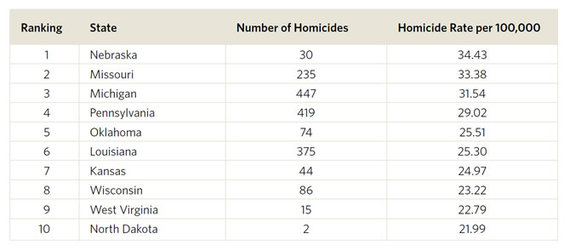Here are a couple of facts that every American should be ashamed of: Black Americans are four times more likely to be murdered than the national average. What's more, four out of five black homicide victims are killed with guns.
Our new Violence Policy Center report, "Black Homicide Victimization in the United States," is a grim reminder that our nation's gun violence epidemic places a disproportionate burden on African Americans. While the daily toll of gun homicide is seen in shopping malls, schools, campuses, movie theaters, and homes across America, African Americans still face the greatest risk of being murdered with a gun.
Our report uses unpublished data from the Federal Bureau of Investigation's Supplementary Homicide Report. The data for this year's report is from 2011, the most recent year for which such information is available.
Our report also ranks the states according to their black homicide victimization rates. This year, Nebraska ranked the highest with a black homicide victimization rate of 34.43 per 100,000, followed by Missouri, Michigan, Pennsylvania, and Oklahoma.
Nationwide, the black homicide victimization rate in 2011 was 17.51 per 100,000. The overall national homicide victimization rate was 4.44 per 100,000, and among white Americans, the homicide victimization rate was 2.64 per 100,000.
As Carl Williams of the Saginaw NAACP in Michigan told a local TV station after his state was found to have the third highest black homicide victimization rate in the nation: "I truly believe if this situation existed in a lot of communities outside of the African American community, it would be declared a national emergency."
The homicide crisis in the black community is overwhelmingly a gun violence problem. Nationwide, when the weapon used could be identified, 82 percent of black homicide victims were shot and killed with guns. Among the victims killed with guns, 77 percent were killed with handguns.
Of course, these are not simply numbers. These are real lives being destroyed, families devastated, entire communities torn apart.
On the same morning we released our report, Ben Gray, an Omaha city councilman, attended the funeral for his grand-niece who was killed by a stray bullet while eating breakfast in her home. The child was five years old.
Gray told the Omaha World-Herald that he is "less interested in the statistics than in what the city, collectively, is going to do about it."
Below are the 10 states with the highest black homicide victimization rates in 2011:
Nationwide, the study also found that:
• Of the 6,309 black homicide victims in the United States, 5,452 were male, 854 were female, and 3 were of unknown gender.
•The homicide rate for black male victims was 31.67 per 100,000. In comparison, the overall homicide rate for male victims was 7.13 per 100,000. For white male victims, the homicide rate was 3.85 per 100,000.
•The homicide rate for black female victims was 4.54 per 100,000. In comparison, the overall homicide rate for female victims was 1.81 per 100,000. For white female victims, the homicide rate was 1.45 per 100,000.
•Four hundred eighty-seven black homicide victims (8 percent) were less than 18 years old and 100 victims (2 percent) were 65 years of age or older. The average age was 30 years old.
•For homicides in which the victim to offender relationship could be identified, 73 percent of black victims (2,138 out of 2,928) were murdered by someone they knew. Seven hundred ninety victims were killed by strangers.
•For homicides in which the circumstances could be identified, 70 percent (2,540 out of 3,652) were not related to the commission of any other felony. Of these, 58 percent (1,475 homicides) involved arguments between the victim and the offender.
These statistics should be a wake-up call for our elected officials to address the disproportionately high homicide victimization rate among black men and women. The longer we wait to act, the more lives will be lost.
Our 2024 Coverage Needs You
It's Another Trump-Biden Showdown — And We Need Your Help
The Future Of Democracy Is At Stake
Our 2024 Coverage Needs You
Your Loyalty Means The World To Us
As Americans head to the polls in 2024, the very future of our country is at stake. At HuffPost, we believe that a free press is critical to creating well-informed voters. That's why our journalism is free for everyone, even though other newsrooms retreat behind expensive paywalls.
Our journalists will continue to cover the twists and turns during this historic presidential election. With your help, we'll bring you hard-hitting investigations, well-researched analysis and timely takes you can't find elsewhere. Reporting in this current political climate is a responsibility we do not take lightly, and we thank you for your support.
Contribute as little as $2 to keep our news free for all.
Can't afford to donate? Support HuffPost by creating a free account and log in while you read.
The 2024 election is heating up, and women's rights, health care, voting rights, and the very future of democracy are all at stake. Donald Trump will face Joe Biden in the most consequential vote of our time. And HuffPost will be there, covering every twist and turn. America's future hangs in the balance. Would you consider contributing to support our journalism and keep it free for all during this critical season?
HuffPost believes news should be accessible to everyone, regardless of their ability to pay for it. We rely on readers like you to help fund our work. Any contribution you can make — even as little as $2 — goes directly toward supporting the impactful journalism that we will continue to produce this year. Thank you for being part of our story.
Can't afford to donate? Support HuffPost by creating a free account and log in while you read.
It's official: Donald Trump will face Joe Biden this fall in the presidential election. As we face the most consequential presidential election of our time, HuffPost is committed to bringing you up-to-date, accurate news about the 2024 race. While other outlets have retreated behind paywalls, you can trust our news will stay free.
But we can't do it without your help. Reader funding is one of the key ways we support our newsroom. Would you consider making a donation to help fund our news during this critical time? Your contributions are vital to supporting a free press.
Contribute as little as $2 to keep our journalism free and accessible to all.
Can't afford to donate? Support HuffPost by creating a free account and log in while you read.
As Americans head to the polls in 2024, the very future of our country is at stake. At HuffPost, we believe that a free press is critical to creating well-informed voters. That's why our journalism is free for everyone, even though other newsrooms retreat behind expensive paywalls.
Our journalists will continue to cover the twists and turns during this historic presidential election. With your help, we'll bring you hard-hitting investigations, well-researched analysis and timely takes you can't find elsewhere. Reporting in this current political climate is a responsibility we do not take lightly, and we thank you for your support.
Contribute as little as $2 to keep our news free for all.
Can't afford to donate? Support HuffPost by creating a free account and log in while you read.
Dear HuffPost Reader
Thank you for your past contribution to HuffPost. We are sincerely grateful for readers like you who help us ensure that we can keep our journalism free for everyone.
The stakes are high this year, and our 2024 coverage could use continued support. Would you consider becoming a regular HuffPost contributor?
Dear HuffPost Reader
Thank you for your past contribution to HuffPost. We are sincerely grateful for readers like you who help us ensure that we can keep our journalism free for everyone.
The stakes are high this year, and our 2024 coverage could use continued support. If circumstances have changed since you last contributed, we hope you'll consider contributing to HuffPost once more.
Already contributed? Log in to hide these messages.

